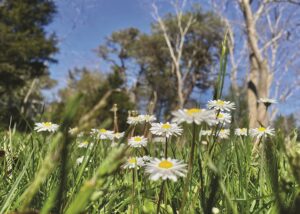It was a lie-in-the-grass type of day, so I listened and lay in the grass. If a day has this feeling, and you have a moment, it’s a good thing to do. The early May sun was strong but not hot. I could lie in it for hours and feel only good.
I might have dozed a little. I rolled over to warm my back. The ground smelled damp and earthy, and I opened my eyes to see the things I smelled. With my face low, my nose nearly touching the ground, the world of the lawn looked suddenly big — indeed, endless. Blades of grass stabbed high into the blue of the sky. Dandelions, massive now, stood like golden suns above the horizon. Their giant globe seed heads were spherical clouds. The lawn daisies became white-canopied trees with shady under-petals. My perspective had shifted, and the world was a new place.

At the top of one tall blade of grass was a burst of yellow-green. This thing was the color of new spring growth. The moment I focused on it, it sprang off into the vast blue sky above, the grass blade left quivering like a diving board. Another blur of the same yellow-green landed in the leaves in front of me. My eyes searched the giant lawn-world at the end of my nose, but the thing had disappeared into the weave and tangle and the unpopped buds.
And then one appeared in front of me, suddenly right there, as if by some quantum leap, clinging to the serrated edge of a gently curving arc of grass. It was a tiny creature with a wide, boxy head and a segmented body that tapered off to a point at its hind end. Two eyes sat at the forward corners of the head, half-spheres a shade lighter than the body. Hair-thin legs radiated from its central segment; there were two smaller ones in the front and two longer legs with sharp-angled bends in them at the hind end. It looked like a miniature cicada crossed with the smallest grasshopper imaginable.
The thing climbed to the top of its arc of grass, held still for a moment, and then, with complete commitment, flung itself out into the vast unknown. What a thing to do! This creature could have no idea where it was to land. What if there was a puddle nearby? What if it landed at the edge of a road or flew off a cliff’s edge? Under the canopy of grass, it could surely not see as far as it could jump. Yet it jumped anyway.

I later did some searching and discovered that the little bug was a potato leafhopper, Empoasca fabae — a scourge of many food growers. This time of year, they are freshly hatched and in their nymph stage. The empty shells my leafhoppers had just hatched from could be seen balanced at the tops of some blades of grass, see-through, like ghosts left behind in the exact contours of their now-living green bodies, hundreds of which bounced through the grass each time I brushed my hand over the surface of the lawn.
Although they are no bigger than a dot made by a dull pencil tip, leafhoppers’ powerful hind legs can launch them up to 100 times their own length at speeds of 13 feet per second. A minuscule system of gears at the “knee” joint turns the legs into a launching machine that would make an engineer jealous. The gears move at 33,000 rotations per minute and produce up to 700 Gs of force, according to research on the kinematics of leafhopper jumping published in the Journal of Experimental Biology. What it takes, I guess, to climb up onto a dandelion and fling itself into the clear blue sky.
Again, my perspective shifted, with insights on jumping into the unknown gained from watching a tiny, trusting bug. The leafhopper knows the world to be only a field of grass. Yet each time it leaps, it believes there will be a soft landing on who knows what — a clover leaf, a fluffy seed head, or a vast, soft pad of golden dandelion petals.



